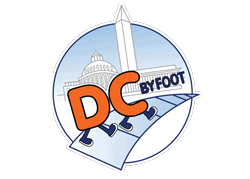The United States Holocaust Memorial Museum is one of the more moving museums to visit in Washington D.C.
It explains the history of the Holocaust - what led to it, the horrific events that unfolded, and the aftermath.
While it is not part of the Smithsonian, it is free to visit but timed tickets are required.
And as local tour guides, we know how sought-after tickets can be.
Especially during peak season, we get asked just about every day how to get tickets, especially last-minute or sold-out tickets.
It's also a common question that we answer in our Washington, DC Travel Tips Facebook Group.
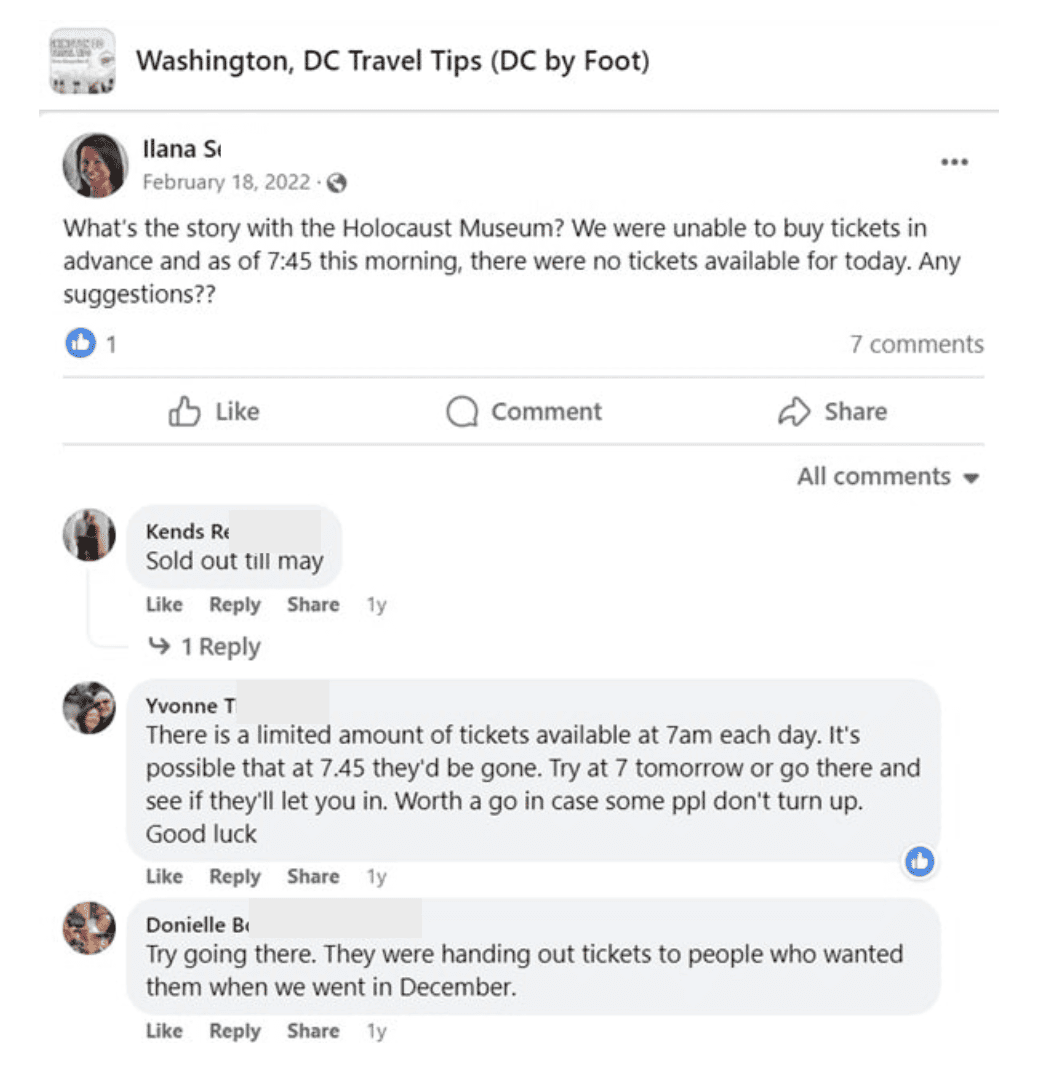
So, we were inspired to create this post to help you get tickets to visit the museum.
WHEN DO YOU NEED TICKETS TO THE HOLOCAUST MUSEUM
You do not need a ticket to enter the museum, traveling exhibit, or Daniel's Story.
You will however still need a ticket to visit the museum's permanent exhibition.
Entry is free. In fact, the Holocaust Museum is one of the top free things to do in DC.
However, if you are getting advanced tickets there is a $1 transaction fee.
The tickets are timed for entrance in a 15-minute window.
This means that if you obtain a ticket for 10 a.m., you have from that time until 10:15 a.m. to enter the Permanent Exhibit.
Below are instructions for getting advanced tickets to the Permanent Exhibit, whether you are bringing your family of 4 or a group of 55 students.
Advanced reservations are taken up to 3 months in advance.
Holocaust Museum tickets are timed. You will have a one-hour slot in which to enter the permanent exhibit.
The group must be in the building, through security and the ticket line before the end time on your ticket.
Late arrivals are only accepted if spaces are allowed.

How to Get Tickets:
If you are not affiliated with a school or tour company, or groups smaller than 55 people, click here.
Tickets for large groups may be reserved up to 3 months prior to the visit.
Groups are given timed tickets, starting at 10 am with the last group going through at 3:30 pm. Link for group tickets.
If you are affiliated with any school group or tour group (the group must have at least 55 people), click here.
INSTRUCTIONS FOR GROUPS
If you are traveling with a group larger than 110 people, you will need to break the group into smaller parts and make a reservation for each individually.
While booking your tickets, you will be taken to a screen and told you have a pending reservation that they will hold for 20 minutes.
If you have never made a reservation on this system before, click on the link that says: Complete My Reservation so you can provide information about your group.
If you have used it before, log in to your account, otherwise, you will need to create an account with your information.
Make sure you take note of the arrival instructions, as groups arrive on the 15th Street side of the Museum, not the main entrance on the 14th.
Plan to arrive a half-hour early, and have your group line up single file from the entrance.
Inform your group that they will be going through security.
It’s important to note that reserving tickets for groups in advance has a convenience charge of $1 per ticket.
Consider DC BY FOOT when bringing your group or school group to Washington, DC.
We are a group of knowledgeable and fun tour guides, experienced with private tours for school, corporate, or VIP groups.
We love what we do and we take pride in our long-term partnerships. For more information on private group tours click here.
SAME-DAY TICKETS
Officially, same-day tickets are NOT distributed at the museum but rather online at 7 a.m. using the same link as above for advanced tickets.
However, we have often seen same-day tickets being handed out at the USHHM in the mornings.
If you are unable to get tickets in advance or want to have some flexibility with your visit to Washington, DC; the Holocaust Memorial Museum does offer same-day tickets.
Tickets are distributed on a first-come, first-served basis beginning at 10 a.m. One person may ask for up to 20 passes.
With proper identification, members of the military, law enforcement, firefighters, and government employees are entitled to obtain non-timed passes.
They must enter the museum and request their complimentary tickets at the information desk.
What time should I line up for same-day tickets?
During the spring season, when there are many school groups visiting the city, the line for same-day tickets begins to form as early as 7 a.m.
If you arrive later the staff will often manage the line so you don't have to wait if they don't think there will be tickets left.
Where to get same-day tickets?
The pass line forms next to the building in the alley with benches.
Staff distributes the passes from the 14th Street side of the alley to allow those with passes to proceed into the building.
The same-day ticket line is one block away from the Smithsonian Metro (Blue/Orange/Silver) Station.
PLAN YOUR VISIT
In this section, we provide details to help make your trip a smooth one, including how to get here, hours of operation, security considerations, food options, as well as nearby attractions to help you plan out your day.
How to get to the Holocaust Memorial Museum
Officially, the Holocaust Museum is located at 100 Raoul Wallenberg Place, but the main tourist entrance is located at 205 14th St. in southwest D.C.
Use this link for directions to the Holocaust Museum from anywhere in the Washington, DC area.
TIP: Our National Mall & Tidal Basin Walking Tour ends at the Jefferson Memorial, approximately a 10-minute walk to the museum.
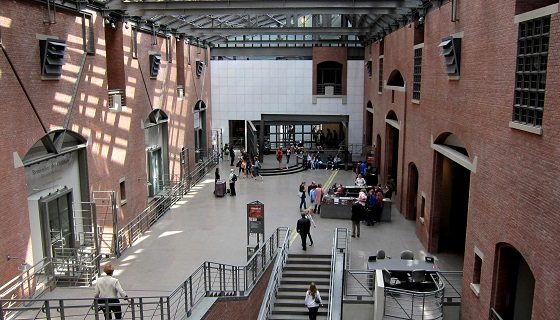
Metro:
The closest Holocaust Museum Metro stop is the Smithsonian (Blue/Orange/Silver) Stop.
Be sure you use the Independence Ave exit and not the Mall exit.
When you exit the station on Independence Ave SW, just head straight two blocks to 14th St SW and you'll see the museum across the street to the left.
Read our tips on how to use the DC Metro system.
Tour Bus:
If you have or are considering purchasing the hop-on-hop-off bus ticket, keep in mind that all relevant companies stop at the Holocaust Museum.
Parking:
Some nearby streets have metered parking but they are subject to hour limits and rush hour restrictions.
There are a few nearby commercial parking facilities.
You can compare prices at these garages and reserve a space at one of your choices through SpotHero.
This service makes the entire parking experience stress-free and can be quite the lifesaver for drivers in Washington DC.
Hours
The Holocaust Museum is open daily with the exception of Yom Kippur and Christmas Day.
- 10:00 am - 5:30 pm (17:30)
The entrance to the Permanent Exhibit closes at 4:30 p.m. (16:30) to allow ample viewing of the exhibit.
Security
The Holocaust Museum has its own police force and security protocols. Entrance to the museum requires airport-like security.
(Keep your shoes on, though!) Any electronics and bags will need to go through the scanner.
While closed food and drinks are allowed, there is no eating, drinking, or gum inside the museum.
Open water bottles are allowed, but you will likely be asked to take a sip before they let it in. Other beverages are not allowed if already opened.
As a reminder, pepper spray and mace are not allowed in DC!
Accessibility
The USHMM is fully accessible.
While the museum is multi-level, there are wheelchair-accessible elevators and ramps.
For those who are blind or have low vision, guided tours with trained docents with descriptions and touchable objects are available with advanced requests.
Visitors who are deaf or hard of hearing will find closed captioning on all multimedia exhibits.
Guided Tours of the Holocaust Museum
The Permanent Exhibit is self-guided and guided tours are not offered by the museum or third parties.
They do offer a student guide that helps younger visitors understand the museum and not get too overwhelmed.
https://vault.ushmm.org/adaptivemedia/rendition/id_eae97da0458e52cd4ece5e4fdc1d0a959d46382f
You can also watch a 39-minute video tour of the Americans and the Holocaust exhibit in advance.
https://www.ushmm.org/teach/holocaust-lesson-plans/americans-and-the-holocaust-tour-viewing-guide
Can I take photographs at the Holocaust Memorial Museum?
Photography is now allowed inside the museum and exhibits, as long as it is done without flash and without interfering in the experience of others.
Photographs in or around the security area, however, are prohibited.
Is there a dress code?
There is no official dress code at the Holocaust Museum.
However, the museum suggests bringing a sweater because the exhibits are kept cold to preserve the artifacts.
It is suggested that dress is respectful due to the content of the museum.
Food/ Other Attractions
There is a Museum Cafe, though it is a separate building from the actual museum.
You will have to go through security to enter the cafe building as well as to re-enter the museum.
Please note that you cannot take food into the museum.
The Cafe has pre-made as well as hot food, often focusing on traditional Jewish dishes.
For groups, there is a boxed lunch option as well. The Museum Cafe closes at 4:30 pm (16:30).
The USHMM is just off the National Mall, meaning it is nearby to many other attractions. We suggest planning your trip to take advantage of things nearby!
The Thomas Jefferson Memorial is about a 10-minute walk so if you plan on visiting the Tidal Basin memorials (Jefferson, MLK, FDR) now is the time to do it.
You are also not far from the museums on the National Mall. These are free and unticketed so no reservations are required.
- American History Museum
- Natural History Museum
- Art Museums
- Air and Space Museum (tickets are required for the National Mall location)
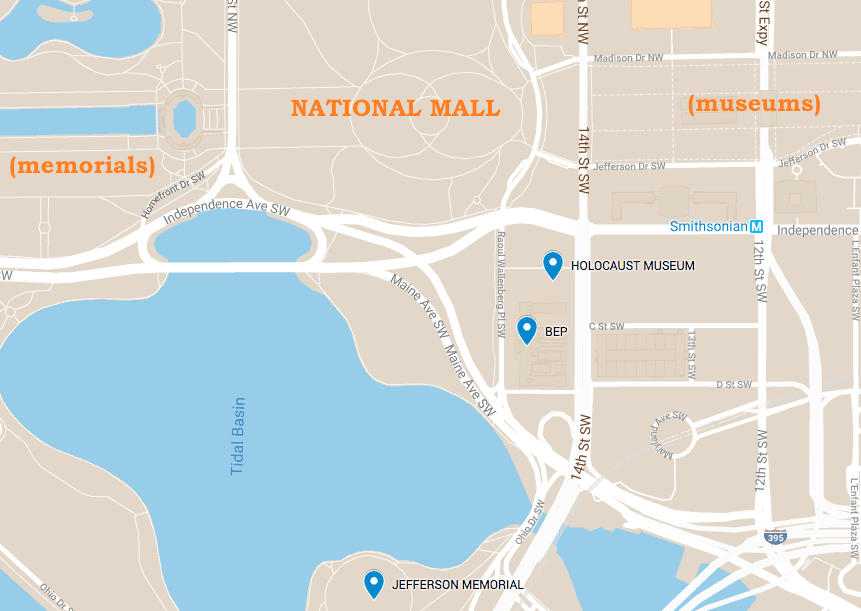
CURRENT AND PERMANENT EXHIBITS
There are many things to see at the Holocaust Museum, but the Permanent Exhibit is a must-see and the one most people are talking about after their visit.
A visit to the museum can be a full-day experience, most of it spent in the Permanent Exhibit.
It is recommended to reserve at least 90 minutes to fully experience this part of the museum.
Depending on your interests, you can easily spend more.
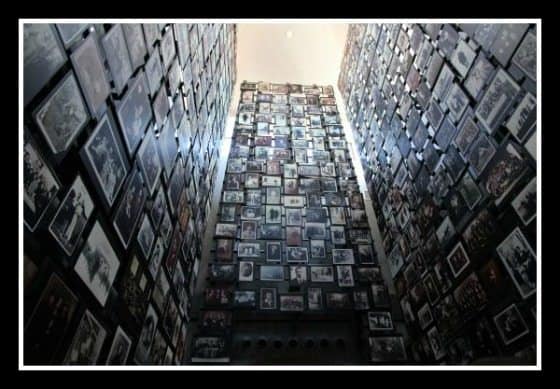
Museum's Permanent Exhibition
It is very moving and follows a chronological path through the times leading up to, during, and after the Holocaust.
There are 3 floors each with its own time frame.
What is most memorable is the passport-like book you receive as you enter.
It tells the story of a real person who went through World War II and the events of the Holocaust.
The book is chronological like the exhibit so as you walk through the museum, you'll also have a personal story of what that person experienced during this same time.
At the end of the exhibit, you'll find out what happened - it can be a heart-wrenching moment, so there is a place for reflection at the exit of the permanent exhibit.
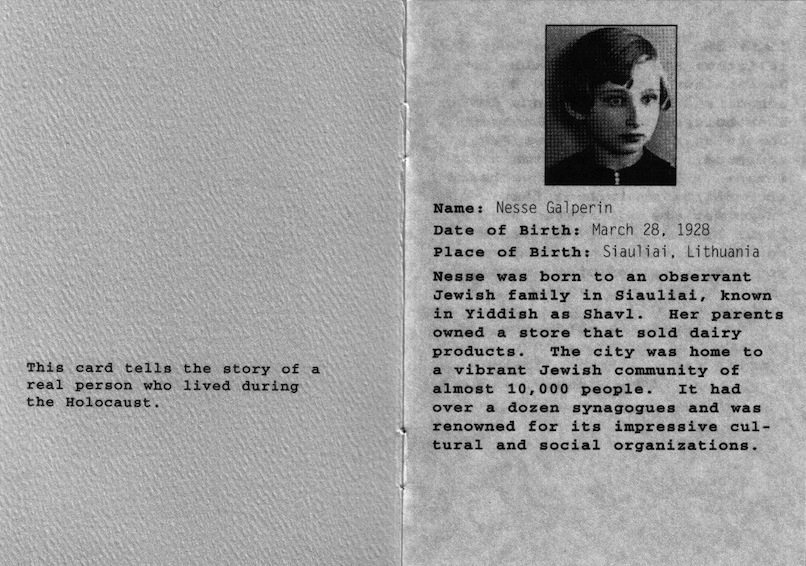
As you start at the top of the Permanent Exhibit, the museum focuses on the events leading up to the Holocaust and the rise of the Nazis from 1933-1939.
There are two films on this floor: The Nazi Rise to Power (13 minutes) and Antisemitism (14 minutes).
The middle level of the exhibit focuses on 1940-45 with the events most associated with the Holocaust - gas chambers, mass murder, and the Nazi policy towards the Jews.
The main focus on this floor is the concentration camps.
Before you reach it, you may be able to sense it - a collection of over 4,000 shoes.
Shoes were one of the many items confiscated from prisoners as they entered concentration camps.
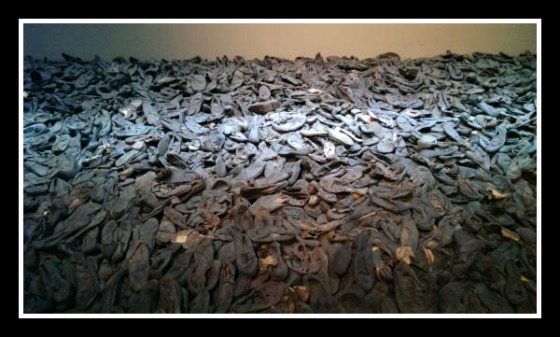
The Final Chapter exhibit highlights the liberation of these camps and the aftermath of the Holocaust.
Exiting the exhibit, you are introduced to a continuous looping video of testimony from Holocaust survivors.
Daniel's Story
Technically, this is a special exhibit but it has been a part of the museum for many years. It follows the story of a child, Daniel, in Nazi Germany from 1933-1945.
It is interactive and includes many videos as you walk through a recreated version of his home where you can touch, feel, and listen.
This exhibit is a way to teach younger children (recommended aged 8+) about the Holocaust for those who may find the Permanent Exhibit to be too graphic.
For more about visiting the Holocaust Museum with kids, read our post here.
Timing: Daniel's Story is meant for children, so it is a shorter visit. Most families will find it takes about 45 minutes to walk through, watch all the videos, and experience it.
At the end, there is an area with young visitors can reflect on what they learned.
Daniel's Story does not require tickets and you can enter anytime the museum is open.
Other Exhibits
Continuing with an exhibit for children, the Children's Tile Wall is in the lower level.
There are over 3,000 tiles that were created and painted by American students in reaction to learning about the Holocaust in the 1980s.
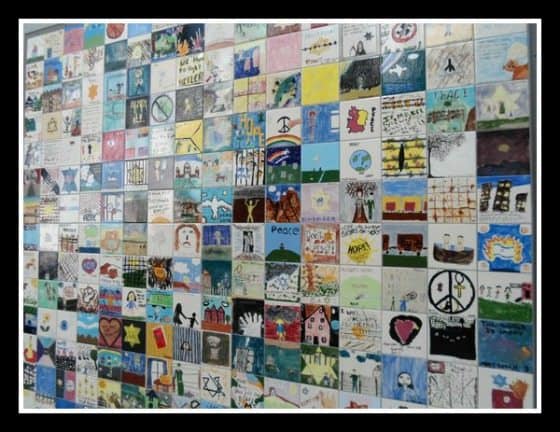
Downstairs you will find special rotating exhibits that focus on other aspects of the Holocaust as well as genocide acts in other countries and times.
Timing: These special exhibits are shorter than the permanent exhibit and take about an hour to visit.
Survivor's Table
Did you know that there is a survivor desk at the United States Holocaust Memorial Museum?
When available, volunteers sit at this desk to answer questions and share their eyewitness testimonies.
One of the survivors is George Salamon, who is frequently at the museum on Wednesdays.
Read more stories: https://www.ushmm.org/remember/holocaust-reflections-testimonies/echoes-of-memory/
Related Content:
